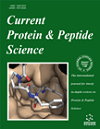- Home
- A-Z Publications
- Current Protein and Peptide Science
- Previous Issues
- Volume 16, Issue 8, 2015
Current Protein and Peptide Science - Volume 16, Issue 8, 2015
Volume 16, Issue 8, 2015
-
-
In Silico Protein-Protein Interactions: Avoiding Data and Method Biases Over Sensitivity and Specificity
More LessThe study of protein-protein interactions (PPIs) can help researchers raise new hypotheses about an organism or disease and guide new experiments. Various methods for the identification and analysis of PPIs have been discussed in the literature. These methods are generally categorized as experimental or computational - each having its own advantages and disadvantages. Experimental methods provide insi Read More
-
-
-
Computational Biology Tools for Identifying Specific Ligand Binding Residues for Novel Agrochemical and Drug Design
More LessThe term “agrochemicals” is used in its generic form to represent a spectrum of pesticides, such as insecticides, fungicides or bactericides. They contain active components designed for optimized pest management and control, therefore allowing for economically sound and labor efficient agricultural production. A “drug” on the other side is a term that is used for compounds designed for controlling human diseases. Althou Read More
-
-
-
DNA Binding Proteins and Drug Delivery Vehicles: Tales of Elephants and Snakes
More LessWe compare the DNA-interactive properties of bacteriophage T4 gene 32 protein (gp32) with those of crotamine, a component of the venom of the South American rattlesnake. Gene 32 protein is a classical single-stranded DNA binding protein that has served as a model for this class of proteins. We discuss its biological functions, structure, binding specificities, and how it controls its own expression. In addition, we delineate the rol Read More
-
-
-
Biophysical Characterisation and Quantification of Nucleic Acid-Protein Interactions: EMSA, MST and SPR
More LessCell viability is only possible due to a dynamic range of essential nucleic acid-protein complex formation. DNA replication and repair, gene expression, transcription and protein synthesis are well-known processes mediated by nucleic acids (DNA and RNA) - protein interactions. Novel nucleic acid- protein complexes have been identified in the past few years aided by the development of numerous new techniques such Read More
-
-
-
From Conformation to Interaction: Techniques to Explore the Hsp70/ Hsp90 Network
More LessProteins participate in almost every cell physiological function, and to do so, they need to reach a state that allows its function by folding and/or exposing surfaces of interactions. Spontaneous folding in the cell is in general hindered by its crowded and viscous environment, which favors misfolding and nonspecific and deleterious self-interactions. To overcome this, cells have a system, in which Hsp70 and Hsp90 play a cen Read More
-
-
-
Protein-Protein and Peptide-Protein Interactions of NudE-Like 1 (Ndel1): A Protein Involved in Schizophrenia
More LessAuthors: M.A.F. Hayashi, L.F. Felicori, M.A.C. Fresqui and C.M. YonamineSchizophrenia (SCZ) is a devastating chronic mental disease determined by genetic and environmental factors, which susceptibility may involve an impaired neural migration during the neurodevelopmental process. Several candidate risk genes potentially associated with SCZ were related to the formation of protein complexes that ultimately mediate alterations in the neuroplasticity. The most studied SCZ risk gene is the Disru Read More
-
-
-
Structural Insights into Substrate Binding of Brown Spider Venom Class II Phospholipases D
More LessAuthors: M.A. Coronado, A. Ullah, L.S. da Silva, D. Chaves-Moreira, L. Vuitika, O.M. Chaim, S.S. Veiga, J. Chahine, M.T. Murakami and R.K. ArniPhospholipases D (PLDs), the major dermonecrotic factors from brown spider venoms, trigger a range of biological reactions both in vitro and in vivo. Despite their clinical relevance in loxoscelism, structural data is restricted to the apo-form of these enzymes, which has been instrumental in understanding the functional differences between the class I and II spider PLDs. The crystal structures of the native class II PLD from Lox Read More
-
-
-
Isolation and Characterization of L-Tryptophan Ammonia Lyase from Rubrivivax benzoatilyticus Strain JA2
More LessAuthors: Ranjith N. Kumavath, Ch.V. Ramana, Ch. Sasikala, Debmalya Barh, Alan Prem Kumar and Vasco AzevedoAmmonia lyase belongs to the family of enzymes that catalyzes the deamination of amino acids. Depending on the relative activity towards the substrates, L-tryptophan ammonia lyase converts L-tryptophan to indole 3-acrylic acid and ammonia. Here, we isolated, purified, and characterized an L-tryptophan ammonia lyase from phototrophic purple non-sulfur bacterium Rubrivivax benzoatilyticus JA2. The isolated L-tryptophan Read More
-
-
-
Using QCM and SPR for the Kinetic Evaluation of the Binding Between A New Recombinant Chimeric Protein and Specific Antibodies of the Visceral Leishmaniasis
More LessAuthors: Denio E. P. Souto, Angelica R. Faria, Helida M. de Andrade and Lauro T. KubotaIn the present study, the surface plasmon resonance (SPR) and quartz crystal microbalance (QCM) techniques were employed to kinetically evaluate the binding affinity of a new recombinant chimeric protein (CP10) toward anti-Leishmania infantum antibodies for the immunodiagnostics of the visceral leishmaniasis (VL). This chimeric protein was formed by the union in a same artificial coding DNA of ten different peptides Read More
-
Volumes & issues
-
Volume 26 (2025)
-
Volume 25 (2024)
-
Volume 24 (2023)
-
Volume 23 (2022)
-
Volume 22 (2021)
-
Volume 21 (2020)
-
Volume 20 (2019)
-
Volume 19 (2018)
-
Volume 18 (2017)
-
Volume 17 (2016)
-
Volume 16 (2015)
-
Volume 15 (2014)
-
Volume 14 (2013)
-
Volume 13 (2012)
-
Volume 12 (2011)
-
Volume 11 (2010)
-
Volume 10 (2009)
-
Volume 9 (2008)
-
Volume 8 (2007)
-
Volume 7 (2006)
-
Volume 6 (2005)
-
Volume 5 (2004)
-
Volume 4 (2003)
-
Volume 3 (2002)
-
Volume 2 (2001)
-
Volume 1 (2000)
Most Read This Month
Article
content/journals/cpps
Journal
10
5
false
en


